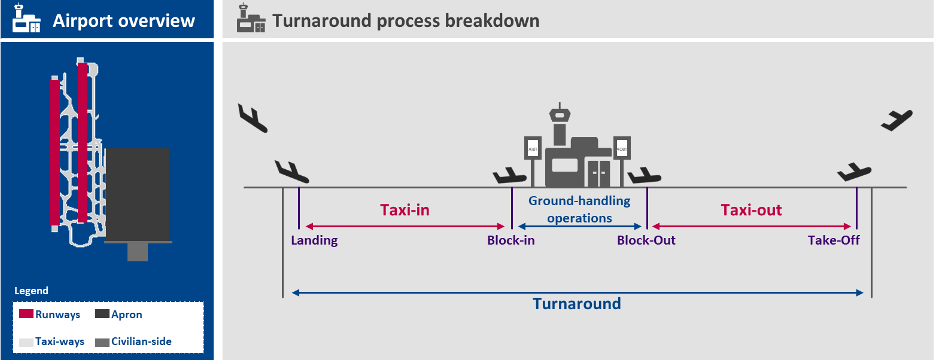This article is part of a series involving the participants of the AI program by Leonard. The program has been specifically designed to accelerate the adoption of IA technologies within the group VINCI. It consists in a five-month incubation period where selected VINCI collaborators follow a learn by doing process where they codevelop an AI-based use case under the coaching and mentoring of the Leonard Team and Eleven consultants.
Oh, how young and naïve was I then… for the moment we would reach the runway entry point, a new louder a clearer speaker would resound in all of the aircraft this time: “Dear passengers, this is your captain speaking, we have been informed that we lost our slot for departure, we are 5th in the queue for take-off, this should delay our trip by approximately 15 to 20 minutes. The cabin crew is at your servi….”. The rest of the sentence would not matter that much, I would just put my headphones back and try to get one or two Metallica songs in before take-off.
Now, a couple of years after, I realize that I was even more naïve that I thought: of course, an on-schedule departure from the gate does not necessarily mean an on-time departure. But also, and maybe most importantly, once I began to understand what an airport’s airside operation management involved and how complex it is, I realized that delays should come as no surprise to me, and that the mere fact of meeting the target departure time was not an easy feat.
Before delving into details regarding how airports work, first let’s have a look at the following picture:

An airport can be broken down to two main areas:
- The civilian side of the airport: that’s where people can walk freely, shop, register…
- The air side if the airport: that’s where vehicles and authorized personnel are located
- In this paper, we will be focusing on the air side.
Getting back to our story, how does an airside operate? At least from an aircraft perspective?
After the aircraft’s approach, it finally lands. This process, known as landing, can also be referred to as ALDT or Actual Landing Time. This marks the moment when the aircraft’s (A/C) wheels touch the ground. After the ALDT, the aircraft starts going towards its dedicated gate or dock that’s the taxi-in. Once the A/C reaches its dock the registered timestamp is called AIBT for Actual In-Block Time. The timespan between the ALDT and the AIBT is the taxi-in time.
After the AIBT, the A/C is processed by ground-handling teams (catering, cleaning, fueling, boarding…) and once it’s ready, it can leave its dock: that’s the AOBT of Actual Off-Block Time. The timespan between the AOBT and the aircraft’s take-off (ATOT – Actual Take-Off Time) is the taxi-out time. And that’s the time that caused so many frustrating experiences to countless passengers. The taxi-out time is paramount to determining when an A/C will be able to take-off. This is due to the fact that if a plane has an AOBT at say 10:35a.m. and that its taxi-out time is 20min, then the runway must be free for the A/C’s take-off at 10:55a.m. otherwise, this would generate a queue at the runway’s entry.
This issue is not a new one in the airports world and many a company developed solutions to help airports operations in this regard. A system located in the tower for instance called DMAN for Departure Manager tries and predicts the taxi-out time. Most of the time however, this time is predicted using a moving average approach, which is not the most accurate of predicting this time and still generates queues.
This problem is transcended in a highly constrained airport like Gatwick. Gatwick airport operates with only one runway for both arrivals and departures indeed. So, optimizing A/C’s movement from and toward that runway is paramount. With the help and support from Leonard’s AI Program, Gatwick airport teams managed to build a taxi-out time prediction algorithm using both circumstantial and operational data to make an accurate forecast for A/C’s taxi-out time.
This optimized taxi-out time prediction is beneficial for three parties:
- For airline companies: the basics of airline companies’ finances in airports is that an aircraft that is not airborne is an aircraft losing money. So, by providing a better taxi-out time prediction and reducing queues at the runway’s entry point, the solution ensures less time spent on the ground for A/Cs, and thus less money lost for airline companies
- For airports: for an airport, the most A/Cs are operated per day, the more money it makes. So by providing a forecast that smoothens the A/C flow, the taxi-out time prediction solution potentially increases the amount of aircrafts that can be operated per day at the airport and thus the money generated by the airport
- For the environment: when an aircraft is queuing at the runway’s entry point, one should know that its engines are still running, so that’s kerosene that is used and GHG emissions generated for virtually nothing. By reducing the queuing time, the solution also reduces the GHG emission levels at airports.